University Nursing Case Study: Post-Angioplasty Care for Mr. Bright
VerifiedAdded on 2023/01/13
|11
|3075
|41
Report
AI Summary
This nursing case study analyzes the post-angioplasty care of Mr. Bright, focusing on assessment frameworks and the ISBAR handover method. The study details the required assessments, including puncture site evaluation, thrombus checks, vital sign monitoring, cardiovascular and neurological assessments (GCS), and blood glucose level monitoring. It also emphasizes the importance of comprehensive medical history review, physical assessments, pain assessment, FAST assessment, and medication assessment. The study uses the ISBAR format to illustrate a nursing handover, detailing the patient's situation, background, assessment findings (including pain, high blood sugar, and FAST score), and recommendations for further care, such as additional ECGs, blood lipid tests, and medication revisions. References from various medical journals and publications are included to support the analysis and recommendations. The report aims to guide nurses in providing comprehensive and effective care to patients post-angioplasty.
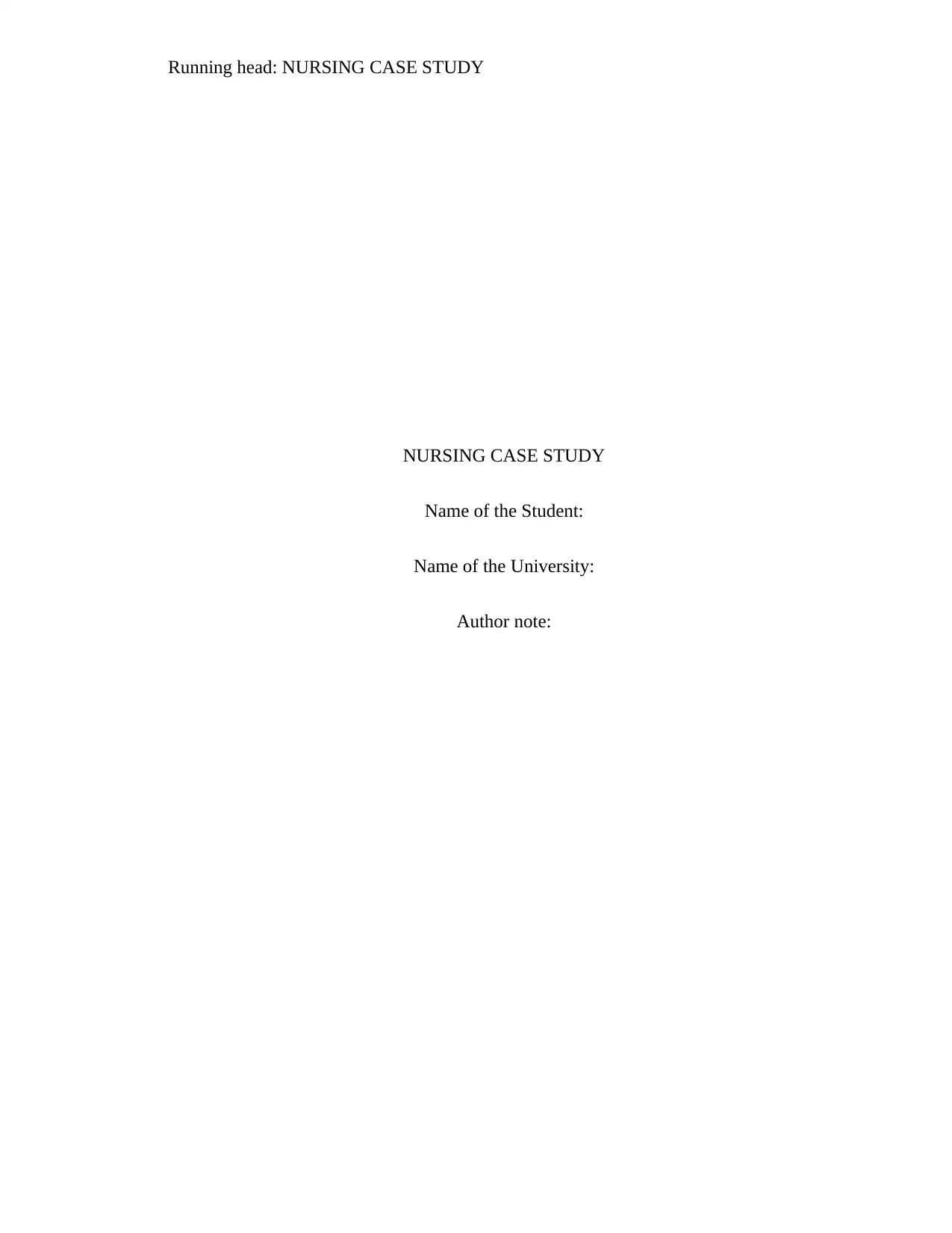
Running head: NURSING CASE STUDY
NURSING CASE STUDY
Name of the Student:
Name of the University:
Author note:
NURSING CASE STUDY
Name of the Student:
Name of the University:
Author note:
Paraphrase This Document
Need a fresh take? Get an instant paraphrase of this document with our AI Paraphraser
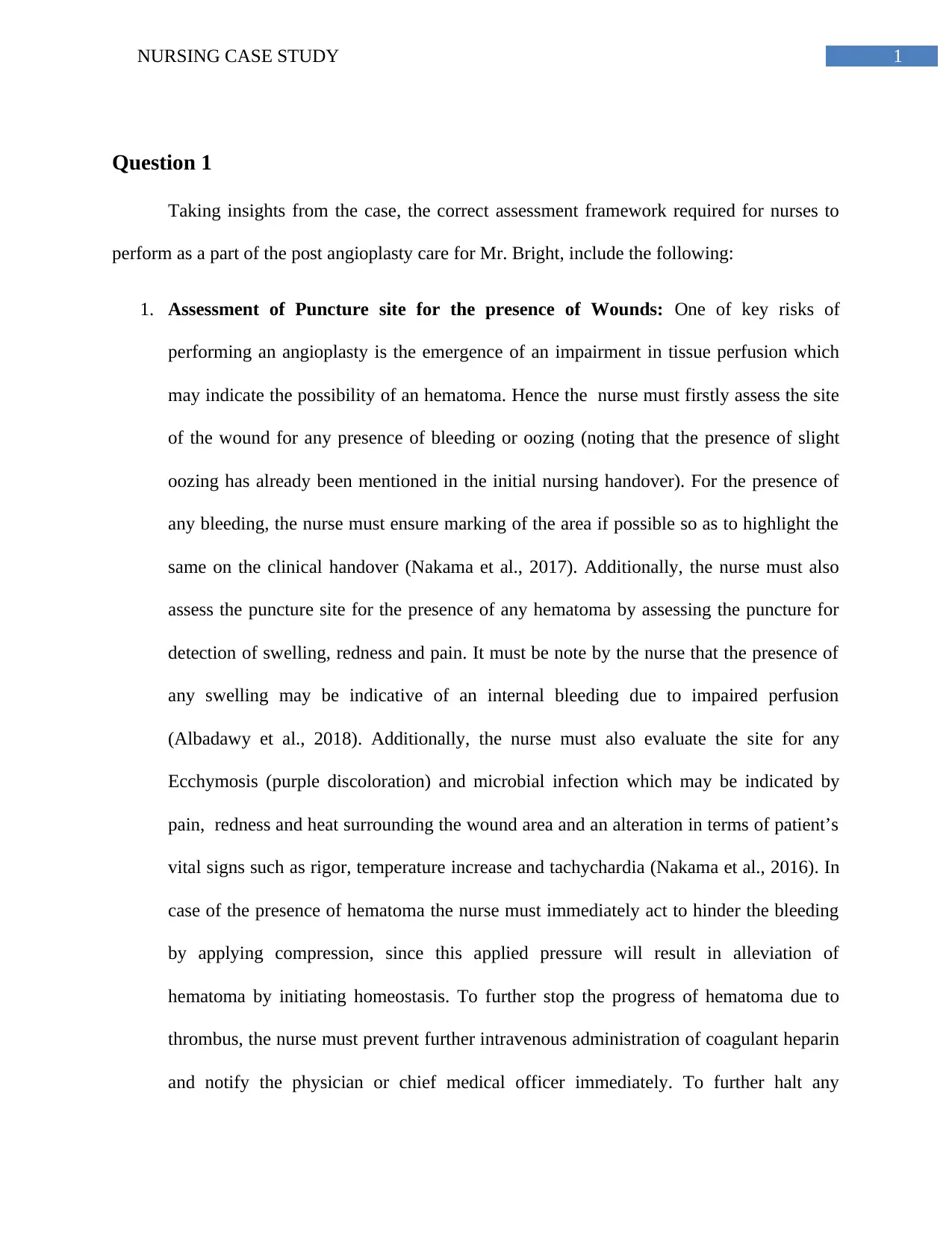
1NURSING CASE STUDY
Question 1
Taking insights from the case, the correct assessment framework required for nurses to
perform as a part of the post angioplasty care for Mr. Bright, include the following:
1. Assessment of Puncture site for the presence of Wounds: One of key risks of
performing an angioplasty is the emergence of an impairment in tissue perfusion which
may indicate the possibility of an hematoma. Hence the nurse must firstly assess the site
of the wound for any presence of bleeding or oozing (noting that the presence of slight
oozing has already been mentioned in the initial nursing handover). For the presence of
any bleeding, the nurse must ensure marking of the area if possible so as to highlight the
same on the clinical handover (Nakama et al., 2017). Additionally, the nurse must also
assess the puncture site for the presence of any hematoma by assessing the puncture for
detection of swelling, redness and pain. It must be note by the nurse that the presence of
any swelling may be indicative of an internal bleeding due to impaired perfusion
(Albadawy et al., 2018). Additionally, the nurse must also evaluate the site for any
Ecchymosis (purple discoloration) and microbial infection which may be indicated by
pain, redness and heat surrounding the wound area and an alteration in terms of patient’s
vital signs such as rigor, temperature increase and tachychardia (Nakama et al., 2016). In
case of the presence of hematoma the nurse must immediately act to hinder the bleeding
by applying compression, since this applied pressure will result in alleviation of
hematoma by initiating homeostasis. To further stop the progress of hematoma due to
thrombus, the nurse must prevent further intravenous administration of coagulant heparin
and notify the physician or chief medical officer immediately. To further halt any
Question 1
Taking insights from the case, the correct assessment framework required for nurses to
perform as a part of the post angioplasty care for Mr. Bright, include the following:
1. Assessment of Puncture site for the presence of Wounds: One of key risks of
performing an angioplasty is the emergence of an impairment in tissue perfusion which
may indicate the possibility of an hematoma. Hence the nurse must firstly assess the site
of the wound for any presence of bleeding or oozing (noting that the presence of slight
oozing has already been mentioned in the initial nursing handover). For the presence of
any bleeding, the nurse must ensure marking of the area if possible so as to highlight the
same on the clinical handover (Nakama et al., 2017). Additionally, the nurse must also
assess the puncture site for the presence of any hematoma by assessing the puncture for
detection of swelling, redness and pain. It must be note by the nurse that the presence of
any swelling may be indicative of an internal bleeding due to impaired perfusion
(Albadawy et al., 2018). Additionally, the nurse must also evaluate the site for any
Ecchymosis (purple discoloration) and microbial infection which may be indicated by
pain, redness and heat surrounding the wound area and an alteration in terms of patient’s
vital signs such as rigor, temperature increase and tachychardia (Nakama et al., 2016). In
case of the presence of hematoma the nurse must immediately act to hinder the bleeding
by applying compression, since this applied pressure will result in alleviation of
hematoma by initiating homeostasis. To further stop the progress of hematoma due to
thrombus, the nurse must prevent further intravenous administration of coagulant heparin
and notify the physician or chief medical officer immediately. To further halt any
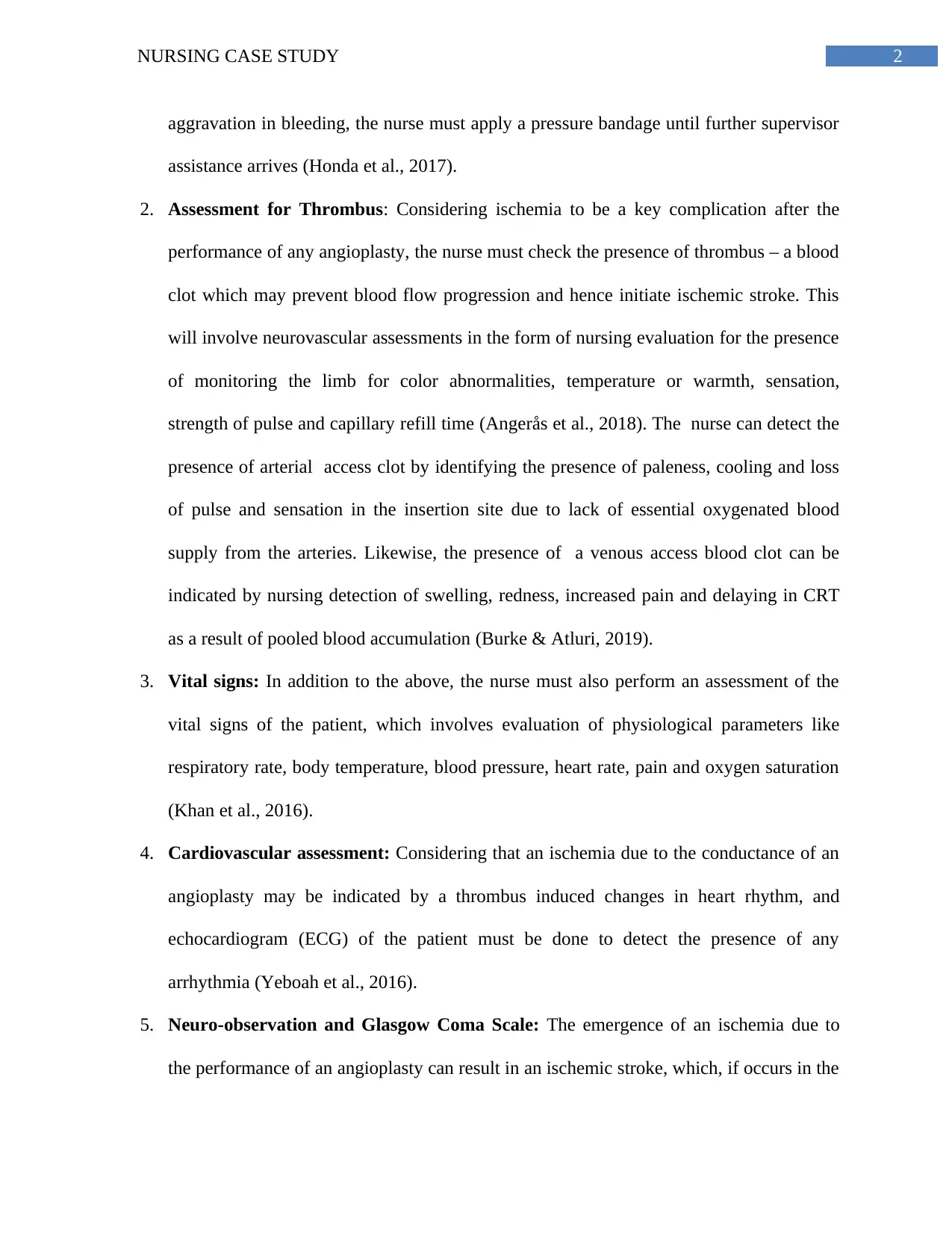
2NURSING CASE STUDY
aggravation in bleeding, the nurse must apply a pressure bandage until further supervisor
assistance arrives (Honda et al., 2017).
2. Assessment for Thrombus: Considering ischemia to be a key complication after the
performance of any angioplasty, the nurse must check the presence of thrombus – a blood
clot which may prevent blood flow progression and hence initiate ischemic stroke. This
will involve neurovascular assessments in the form of nursing evaluation for the presence
of monitoring the limb for color abnormalities, temperature or warmth, sensation,
strength of pulse and capillary refill time (Angerås et al., 2018). The nurse can detect the
presence of arterial access clot by identifying the presence of paleness, cooling and loss
of pulse and sensation in the insertion site due to lack of essential oxygenated blood
supply from the arteries. Likewise, the presence of a venous access blood clot can be
indicated by nursing detection of swelling, redness, increased pain and delaying in CRT
as a result of pooled blood accumulation (Burke & Atluri, 2019).
3. Vital signs: In addition to the above, the nurse must also perform an assessment of the
vital signs of the patient, which involves evaluation of physiological parameters like
respiratory rate, body temperature, blood pressure, heart rate, pain and oxygen saturation
(Khan et al., 2016).
4. Cardiovascular assessment: Considering that an ischemia due to the conductance of an
angioplasty may be indicated by a thrombus induced changes in heart rhythm, and
echocardiogram (ECG) of the patient must be done to detect the presence of any
arrhythmia (Yeboah et al., 2016).
5. Neuro-observation and Glasgow Coma Scale: The emergence of an ischemia due to
the performance of an angioplasty can result in an ischemic stroke, which, if occurs in the
aggravation in bleeding, the nurse must apply a pressure bandage until further supervisor
assistance arrives (Honda et al., 2017).
2. Assessment for Thrombus: Considering ischemia to be a key complication after the
performance of any angioplasty, the nurse must check the presence of thrombus – a blood
clot which may prevent blood flow progression and hence initiate ischemic stroke. This
will involve neurovascular assessments in the form of nursing evaluation for the presence
of monitoring the limb for color abnormalities, temperature or warmth, sensation,
strength of pulse and capillary refill time (Angerås et al., 2018). The nurse can detect the
presence of arterial access clot by identifying the presence of paleness, cooling and loss
of pulse and sensation in the insertion site due to lack of essential oxygenated blood
supply from the arteries. Likewise, the presence of a venous access blood clot can be
indicated by nursing detection of swelling, redness, increased pain and delaying in CRT
as a result of pooled blood accumulation (Burke & Atluri, 2019).
3. Vital signs: In addition to the above, the nurse must also perform an assessment of the
vital signs of the patient, which involves evaluation of physiological parameters like
respiratory rate, body temperature, blood pressure, heart rate, pain and oxygen saturation
(Khan et al., 2016).
4. Cardiovascular assessment: Considering that an ischemia due to the conductance of an
angioplasty may be indicated by a thrombus induced changes in heart rhythm, and
echocardiogram (ECG) of the patient must be done to detect the presence of any
arrhythmia (Yeboah et al., 2016).
5. Neuro-observation and Glasgow Coma Scale: The emergence of an ischemia due to
the performance of an angioplasty can result in an ischemic stroke, which, if occurs in the
⊘ This is a preview!⊘
Do you want full access?
Subscribe today to unlock all pages.

Trusted by 1+ million students worldwide

3NURSING CASE STUDY
cerebral area, can result in the loss of cognitive functioning, orientation and
consciousness (Reith et al., 2016). Hence to assess the state of consciousness and
orientation in Mr. Bright after post angioplasty performance the nurse must conduct a
GCS and Neuro-obs which will involve evaluation of facial symmetry (for presence of
facial paralysis), monitoring of patient pupil rounding, reaction to light, accommodation
and identification of patient’s level of consciousness such as the presence of coma,
lethargy, stupor, obtundation and consciousness (Chou et al., 2017).
6. Assessment of blood glucose level: It is worthwhile to consider that the patient has a
history of diabetes, an assessment of the patient’s blood levels of blood sugar must be
conducted since high blood sugar levels can result in hypertension, increased endothelial
adiposity, atherosclerosis and the resultant emergence of plaque formation, ischemia and
stroke (Sarrafzadegan et al., 2017).
Taking insights from the case study, it can be observed that the above assessments had
been conducted as evident in the provided handover mentioning that Mr. Bright’s puncture site
had no presence of oozing, bleeding and hematoma, his vital signs, state of orientation and
consciousness in normal, and ECG has been provided and his diabetes has been kept under
control. However, it must be noted that a number of assessments are still requited to be
conducted as per the patient’s health condition, which have been outlined below:
1. Assessment of Medical history: The nurse must conduct a thorough patient centered
assessment of the medical history of the patient as per Standard 1 of the Nursing and
Midwifery Boars of Australia (2019) and evaluate the age and gender of the patient, as
well as the presence of any past medicine usage, treatment adherence and detrimental
lifestyle or disease conditions. Taking insights from the case, it must be noted that the
cerebral area, can result in the loss of cognitive functioning, orientation and
consciousness (Reith et al., 2016). Hence to assess the state of consciousness and
orientation in Mr. Bright after post angioplasty performance the nurse must conduct a
GCS and Neuro-obs which will involve evaluation of facial symmetry (for presence of
facial paralysis), monitoring of patient pupil rounding, reaction to light, accommodation
and identification of patient’s level of consciousness such as the presence of coma,
lethargy, stupor, obtundation and consciousness (Chou et al., 2017).
6. Assessment of blood glucose level: It is worthwhile to consider that the patient has a
history of diabetes, an assessment of the patient’s blood levels of blood sugar must be
conducted since high blood sugar levels can result in hypertension, increased endothelial
adiposity, atherosclerosis and the resultant emergence of plaque formation, ischemia and
stroke (Sarrafzadegan et al., 2017).
Taking insights from the case study, it can be observed that the above assessments had
been conducted as evident in the provided handover mentioning that Mr. Bright’s puncture site
had no presence of oozing, bleeding and hematoma, his vital signs, state of orientation and
consciousness in normal, and ECG has been provided and his diabetes has been kept under
control. However, it must be noted that a number of assessments are still requited to be
conducted as per the patient’s health condition, which have been outlined below:
1. Assessment of Medical history: The nurse must conduct a thorough patient centered
assessment of the medical history of the patient as per Standard 1 of the Nursing and
Midwifery Boars of Australia (2019) and evaluate the age and gender of the patient, as
well as the presence of any past medicine usage, treatment adherence and detrimental
lifestyle or disease conditions. Taking insights from the case, it must be noted that the
Paraphrase This Document
Need a fresh take? Get an instant paraphrase of this document with our AI Paraphraser
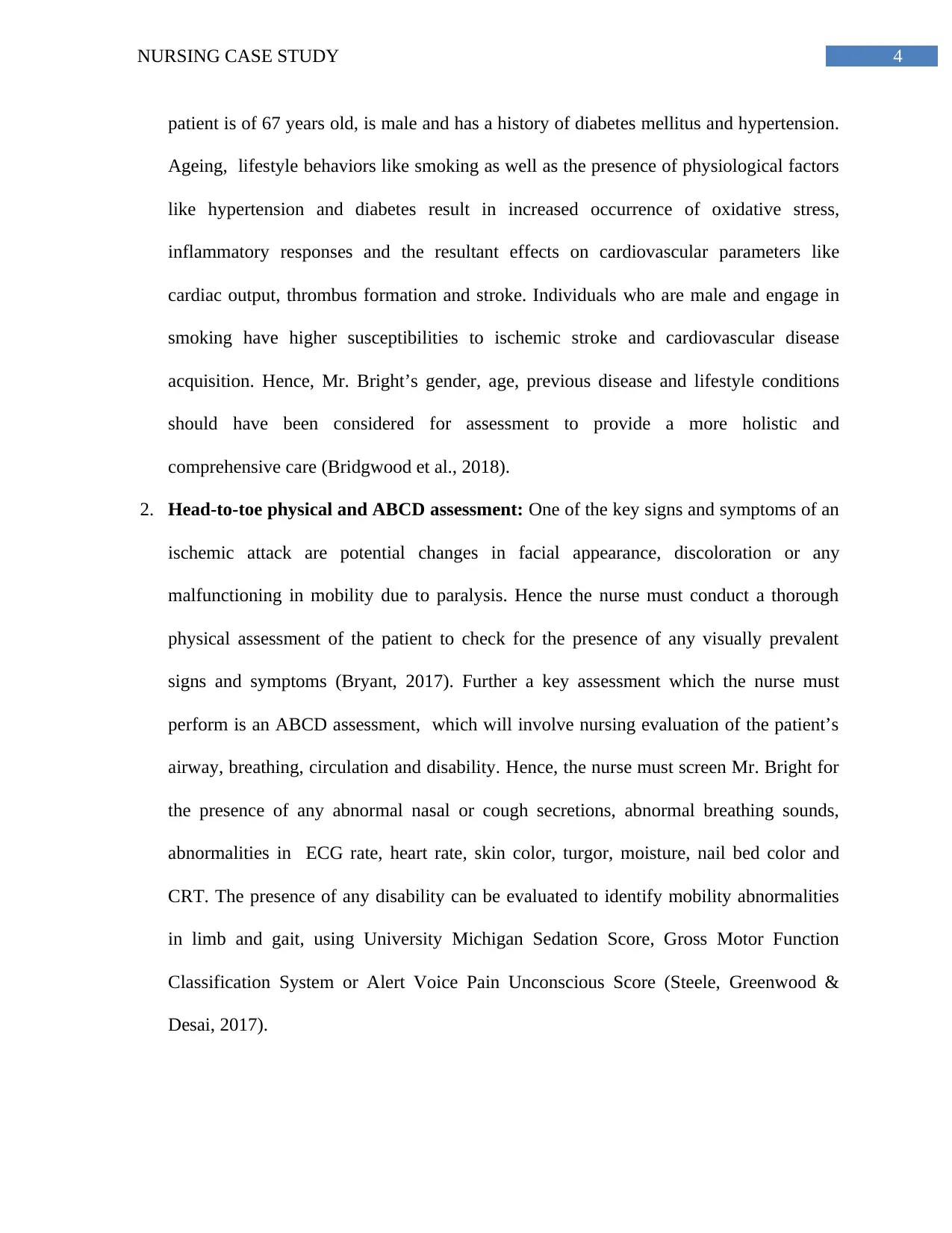
4NURSING CASE STUDY
patient is of 67 years old, is male and has a history of diabetes mellitus and hypertension.
Ageing, lifestyle behaviors like smoking as well as the presence of physiological factors
like hypertension and diabetes result in increased occurrence of oxidative stress,
inflammatory responses and the resultant effects on cardiovascular parameters like
cardiac output, thrombus formation and stroke. Individuals who are male and engage in
smoking have higher susceptibilities to ischemic stroke and cardiovascular disease
acquisition. Hence, Mr. Bright’s gender, age, previous disease and lifestyle conditions
should have been considered for assessment to provide a more holistic and
comprehensive care (Bridgwood et al., 2018).
2. Head-to-toe physical and ABCD assessment: One of the key signs and symptoms of an
ischemic attack are potential changes in facial appearance, discoloration or any
malfunctioning in mobility due to paralysis. Hence the nurse must conduct a thorough
physical assessment of the patient to check for the presence of any visually prevalent
signs and symptoms (Bryant, 2017). Further a key assessment which the nurse must
perform is an ABCD assessment, which will involve nursing evaluation of the patient’s
airway, breathing, circulation and disability. Hence, the nurse must screen Mr. Bright for
the presence of any abnormal nasal or cough secretions, abnormal breathing sounds,
abnormalities in ECG rate, heart rate, skin color, turgor, moisture, nail bed color and
CRT. The presence of any disability can be evaluated to identify mobility abnormalities
in limb and gait, using University Michigan Sedation Score, Gross Motor Function
Classification System or Alert Voice Pain Unconscious Score (Steele, Greenwood &
Desai, 2017).
patient is of 67 years old, is male and has a history of diabetes mellitus and hypertension.
Ageing, lifestyle behaviors like smoking as well as the presence of physiological factors
like hypertension and diabetes result in increased occurrence of oxidative stress,
inflammatory responses and the resultant effects on cardiovascular parameters like
cardiac output, thrombus formation and stroke. Individuals who are male and engage in
smoking have higher susceptibilities to ischemic stroke and cardiovascular disease
acquisition. Hence, Mr. Bright’s gender, age, previous disease and lifestyle conditions
should have been considered for assessment to provide a more holistic and
comprehensive care (Bridgwood et al., 2018).
2. Head-to-toe physical and ABCD assessment: One of the key signs and symptoms of an
ischemic attack are potential changes in facial appearance, discoloration or any
malfunctioning in mobility due to paralysis. Hence the nurse must conduct a thorough
physical assessment of the patient to check for the presence of any visually prevalent
signs and symptoms (Bryant, 2017). Further a key assessment which the nurse must
perform is an ABCD assessment, which will involve nursing evaluation of the patient’s
airway, breathing, circulation and disability. Hence, the nurse must screen Mr. Bright for
the presence of any abnormal nasal or cough secretions, abnormal breathing sounds,
abnormalities in ECG rate, heart rate, skin color, turgor, moisture, nail bed color and
CRT. The presence of any disability can be evaluated to identify mobility abnormalities
in limb and gait, using University Michigan Sedation Score, Gross Motor Function
Classification System or Alert Voice Pain Unconscious Score (Steele, Greenwood &
Desai, 2017).

5NURSING CASE STUDY
3. Pain Assessment: It must be noted that after a considerable time post the angioplasty
procedure, Mr. Bright has complained of the pain, which has not been estimated further
after resolution due to medication administration. Hence, the nurse must conduct a pain
assessment which will provide key insights on nature, location and area of pain, using
assessment tools such as Flacc (Face, Legs, Activity, Cry, Consolability), PQRST
(Palliative/Provoking, Quality, Radiation, Severity, Timing) assessment tool and
additional physiological parameter assessment such as: blood pressure, oxygen
saturation, heart rate and respiratory rate (Harrison & Field, 2015).
4. FAST Assessment: One of the key assessment tools which the nurse must conduct in
order to detect the presence of any ischemic stroke, include the FAST assessment tool,
which involves: evaluating the patient for facial drooping, weakness in the arm,
difficulties in speech and the need or time to call services of emergency (Nogueira et al.,
2017).
5. Medication Assessment: Mr. Bright’s dosages of medications must be asses and revised
if needed. Hence, excessive heparin administration intravenously may be modified to
prevent blood coagulation. Likewise, dosages of nitroglycerin must be monitored to
prevent side effects such as headaches, flushing, weakness, dizziness, nausea and
dizziness (Jamison et al., 2016).
6. Blood Glucose Level Monitoring: Considering that Mr. Bright is a diabetic and high
sugar levels is a prerequisite of cardiovascular malfunctioning like stroke, his blood
glucose levels must be prioritized – as evident in his blood glucose levels to be higher
than the recommended levels (Chen, Ovbiagele & Feng, 2016).
3. Pain Assessment: It must be noted that after a considerable time post the angioplasty
procedure, Mr. Bright has complained of the pain, which has not been estimated further
after resolution due to medication administration. Hence, the nurse must conduct a pain
assessment which will provide key insights on nature, location and area of pain, using
assessment tools such as Flacc (Face, Legs, Activity, Cry, Consolability), PQRST
(Palliative/Provoking, Quality, Radiation, Severity, Timing) assessment tool and
additional physiological parameter assessment such as: blood pressure, oxygen
saturation, heart rate and respiratory rate (Harrison & Field, 2015).
4. FAST Assessment: One of the key assessment tools which the nurse must conduct in
order to detect the presence of any ischemic stroke, include the FAST assessment tool,
which involves: evaluating the patient for facial drooping, weakness in the arm,
difficulties in speech and the need or time to call services of emergency (Nogueira et al.,
2017).
5. Medication Assessment: Mr. Bright’s dosages of medications must be asses and revised
if needed. Hence, excessive heparin administration intravenously may be modified to
prevent blood coagulation. Likewise, dosages of nitroglycerin must be monitored to
prevent side effects such as headaches, flushing, weakness, dizziness, nausea and
dizziness (Jamison et al., 2016).
6. Blood Glucose Level Monitoring: Considering that Mr. Bright is a diabetic and high
sugar levels is a prerequisite of cardiovascular malfunctioning like stroke, his blood
glucose levels must be prioritized – as evident in his blood glucose levels to be higher
than the recommended levels (Chen, Ovbiagele & Feng, 2016).
⊘ This is a preview!⊘
Do you want full access?
Subscribe today to unlock all pages.

Trusted by 1+ million students worldwide
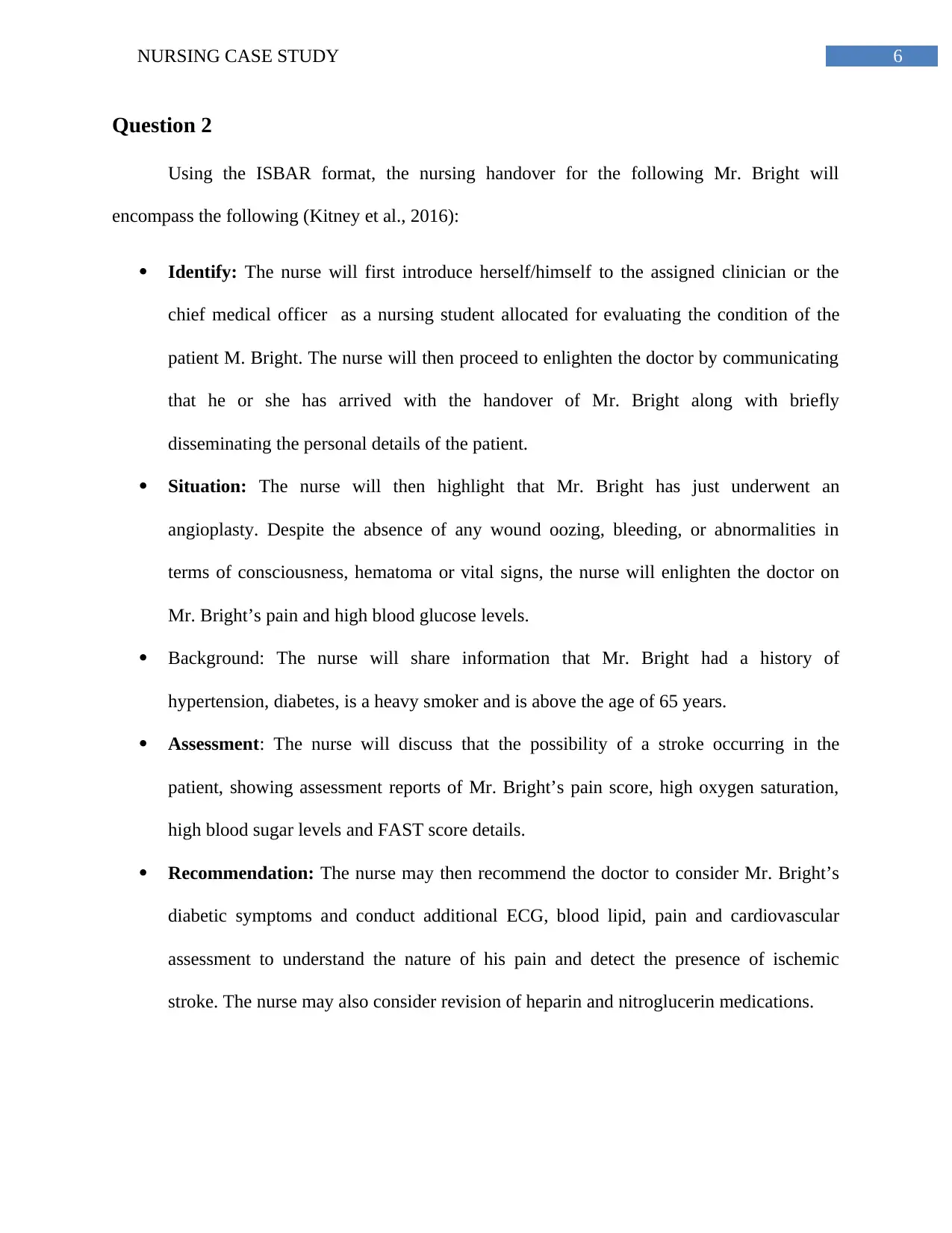
6NURSING CASE STUDY
Question 2
Using the ISBAR format, the nursing handover for the following Mr. Bright will
encompass the following (Kitney et al., 2016):
Identify: The nurse will first introduce herself/himself to the assigned clinician or the
chief medical officer as a nursing student allocated for evaluating the condition of the
patient M. Bright. The nurse will then proceed to enlighten the doctor by communicating
that he or she has arrived with the handover of Mr. Bright along with briefly
disseminating the personal details of the patient.
Situation: The nurse will then highlight that Mr. Bright has just underwent an
angioplasty. Despite the absence of any wound oozing, bleeding, or abnormalities in
terms of consciousness, hematoma or vital signs, the nurse will enlighten the doctor on
Mr. Bright’s pain and high blood glucose levels.
Background: The nurse will share information that Mr. Bright had a history of
hypertension, diabetes, is a heavy smoker and is above the age of 65 years.
Assessment: The nurse will discuss that the possibility of a stroke occurring in the
patient, showing assessment reports of Mr. Bright’s pain score, high oxygen saturation,
high blood sugar levels and FAST score details.
Recommendation: The nurse may then recommend the doctor to consider Mr. Bright’s
diabetic symptoms and conduct additional ECG, blood lipid, pain and cardiovascular
assessment to understand the nature of his pain and detect the presence of ischemic
stroke. The nurse may also consider revision of heparin and nitroglucerin medications.
Question 2
Using the ISBAR format, the nursing handover for the following Mr. Bright will
encompass the following (Kitney et al., 2016):
Identify: The nurse will first introduce herself/himself to the assigned clinician or the
chief medical officer as a nursing student allocated for evaluating the condition of the
patient M. Bright. The nurse will then proceed to enlighten the doctor by communicating
that he or she has arrived with the handover of Mr. Bright along with briefly
disseminating the personal details of the patient.
Situation: The nurse will then highlight that Mr. Bright has just underwent an
angioplasty. Despite the absence of any wound oozing, bleeding, or abnormalities in
terms of consciousness, hematoma or vital signs, the nurse will enlighten the doctor on
Mr. Bright’s pain and high blood glucose levels.
Background: The nurse will share information that Mr. Bright had a history of
hypertension, diabetes, is a heavy smoker and is above the age of 65 years.
Assessment: The nurse will discuss that the possibility of a stroke occurring in the
patient, showing assessment reports of Mr. Bright’s pain score, high oxygen saturation,
high blood sugar levels and FAST score details.
Recommendation: The nurse may then recommend the doctor to consider Mr. Bright’s
diabetic symptoms and conduct additional ECG, blood lipid, pain and cardiovascular
assessment to understand the nature of his pain and detect the presence of ischemic
stroke. The nurse may also consider revision of heparin and nitroglucerin medications.
Paraphrase This Document
Need a fresh take? Get an instant paraphrase of this document with our AI Paraphraser
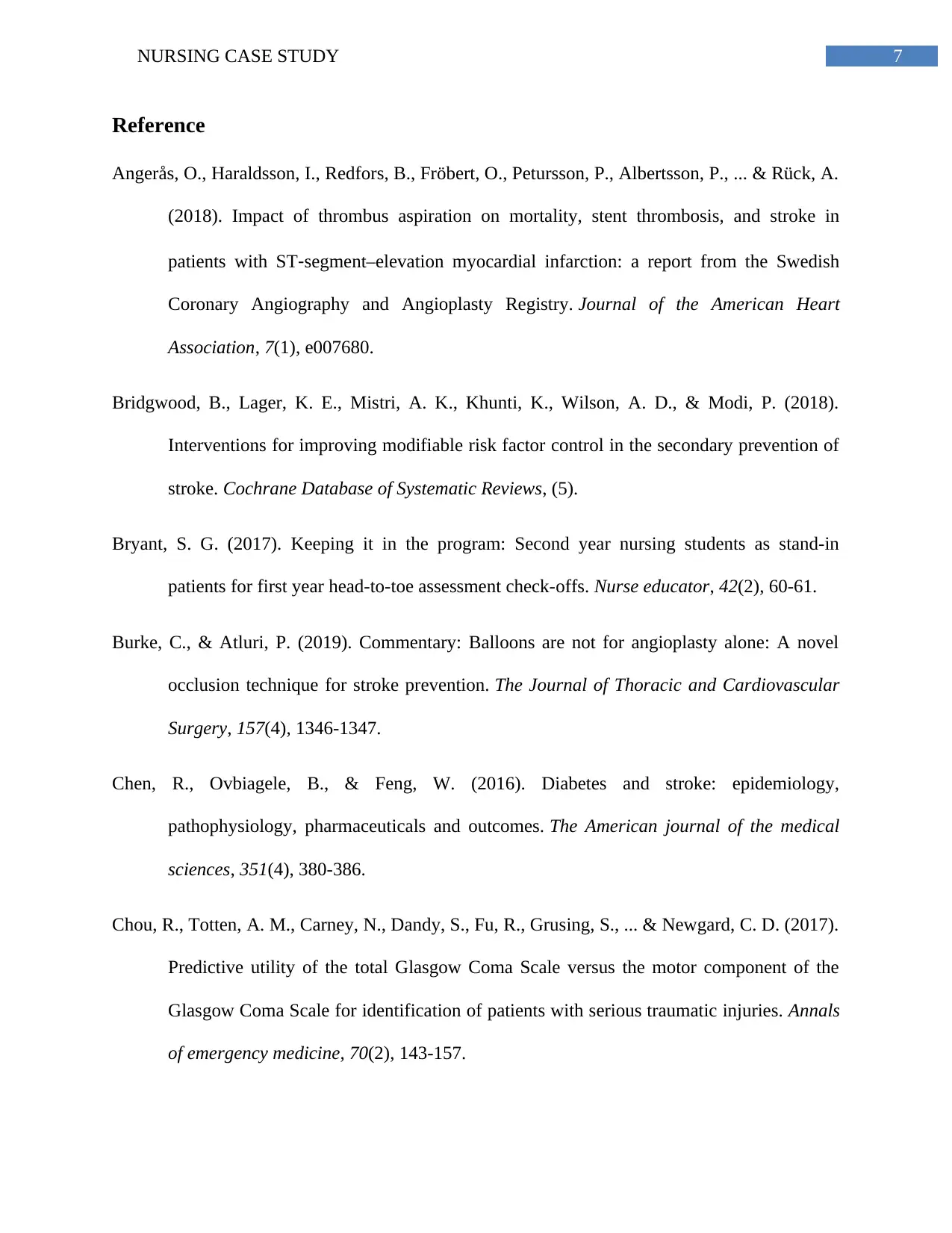
7NURSING CASE STUDY
Reference
Angerås, O., Haraldsson, I., Redfors, B., Fröbert, O., Petursson, P., Albertsson, P., ... & Rück, A.
(2018). Impact of thrombus aspiration on mortality, stent thrombosis, and stroke in
patients with ST‐segment–elevation myocardial infarction: a report from the Swedish
Coronary Angiography and Angioplasty Registry. Journal of the American Heart
Association, 7(1), e007680.
Bridgwood, B., Lager, K. E., Mistri, A. K., Khunti, K., Wilson, A. D., & Modi, P. (2018).
Interventions for improving modifiable risk factor control in the secondary prevention of
stroke. Cochrane Database of Systematic Reviews, (5).
Bryant, S. G. (2017). Keeping it in the program: Second year nursing students as stand-in
patients for first year head-to-toe assessment check-offs. Nurse educator, 42(2), 60-61.
Burke, C., & Atluri, P. (2019). Commentary: Balloons are not for angioplasty alone: A novel
occlusion technique for stroke prevention. The Journal of Thoracic and Cardiovascular
Surgery, 157(4), 1346-1347.
Chen, R., Ovbiagele, B., & Feng, W. (2016). Diabetes and stroke: epidemiology,
pathophysiology, pharmaceuticals and outcomes. The American journal of the medical
sciences, 351(4), 380-386.
Chou, R., Totten, A. M., Carney, N., Dandy, S., Fu, R., Grusing, S., ... & Newgard, C. D. (2017).
Predictive utility of the total Glasgow Coma Scale versus the motor component of the
Glasgow Coma Scale for identification of patients with serious traumatic injuries. Annals
of emergency medicine, 70(2), 143-157.
Reference
Angerås, O., Haraldsson, I., Redfors, B., Fröbert, O., Petursson, P., Albertsson, P., ... & Rück, A.
(2018). Impact of thrombus aspiration on mortality, stent thrombosis, and stroke in
patients with ST‐segment–elevation myocardial infarction: a report from the Swedish
Coronary Angiography and Angioplasty Registry. Journal of the American Heart
Association, 7(1), e007680.
Bridgwood, B., Lager, K. E., Mistri, A. K., Khunti, K., Wilson, A. D., & Modi, P. (2018).
Interventions for improving modifiable risk factor control in the secondary prevention of
stroke. Cochrane Database of Systematic Reviews, (5).
Bryant, S. G. (2017). Keeping it in the program: Second year nursing students as stand-in
patients for first year head-to-toe assessment check-offs. Nurse educator, 42(2), 60-61.
Burke, C., & Atluri, P. (2019). Commentary: Balloons are not for angioplasty alone: A novel
occlusion technique for stroke prevention. The Journal of Thoracic and Cardiovascular
Surgery, 157(4), 1346-1347.
Chen, R., Ovbiagele, B., & Feng, W. (2016). Diabetes and stroke: epidemiology,
pathophysiology, pharmaceuticals and outcomes. The American journal of the medical
sciences, 351(4), 380-386.
Chou, R., Totten, A. M., Carney, N., Dandy, S., Fu, R., Grusing, S., ... & Newgard, C. D. (2017).
Predictive utility of the total Glasgow Coma Scale versus the motor component of the
Glasgow Coma Scale for identification of patients with serious traumatic injuries. Annals
of emergency medicine, 70(2), 143-157.
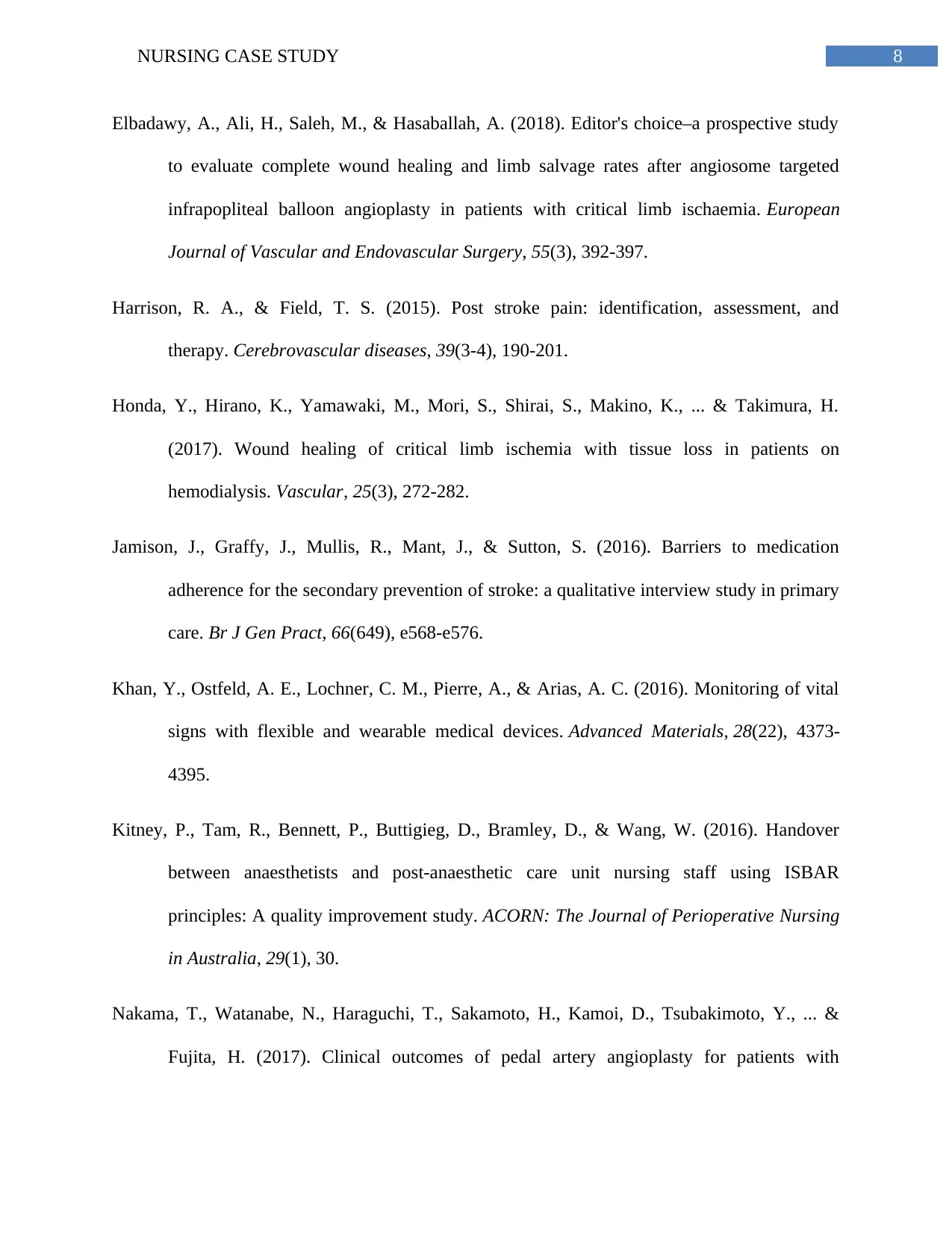
8NURSING CASE STUDY
Elbadawy, A., Ali, H., Saleh, M., & Hasaballah, A. (2018). Editor's choice–a prospective study
to evaluate complete wound healing and limb salvage rates after angiosome targeted
infrapopliteal balloon angioplasty in patients with critical limb ischaemia. European
Journal of Vascular and Endovascular Surgery, 55(3), 392-397.
Harrison, R. A., & Field, T. S. (2015). Post stroke pain: identification, assessment, and
therapy. Cerebrovascular diseases, 39(3-4), 190-201.
Honda, Y., Hirano, K., Yamawaki, M., Mori, S., Shirai, S., Makino, K., ... & Takimura, H.
(2017). Wound healing of critical limb ischemia with tissue loss in patients on
hemodialysis. Vascular, 25(3), 272-282.
Jamison, J., Graffy, J., Mullis, R., Mant, J., & Sutton, S. (2016). Barriers to medication
adherence for the secondary prevention of stroke: a qualitative interview study in primary
care. Br J Gen Pract, 66(649), e568-e576.
Khan, Y., Ostfeld, A. E., Lochner, C. M., Pierre, A., & Arias, A. C. (2016). Monitoring of vital
signs with flexible and wearable medical devices. Advanced Materials, 28(22), 4373-
4395.
Kitney, P., Tam, R., Bennett, P., Buttigieg, D., Bramley, D., & Wang, W. (2016). Handover
between anaesthetists and post-anaesthetic care unit nursing staff using ISBAR
principles: A quality improvement study. ACORN: The Journal of Perioperative Nursing
in Australia, 29(1), 30.
Nakama, T., Watanabe, N., Haraguchi, T., Sakamoto, H., Kamoi, D., Tsubakimoto, Y., ... &
Fujita, H. (2017). Clinical outcomes of pedal artery angioplasty for patients with
Elbadawy, A., Ali, H., Saleh, M., & Hasaballah, A. (2018). Editor's choice–a prospective study
to evaluate complete wound healing and limb salvage rates after angiosome targeted
infrapopliteal balloon angioplasty in patients with critical limb ischaemia. European
Journal of Vascular and Endovascular Surgery, 55(3), 392-397.
Harrison, R. A., & Field, T. S. (2015). Post stroke pain: identification, assessment, and
therapy. Cerebrovascular diseases, 39(3-4), 190-201.
Honda, Y., Hirano, K., Yamawaki, M., Mori, S., Shirai, S., Makino, K., ... & Takimura, H.
(2017). Wound healing of critical limb ischemia with tissue loss in patients on
hemodialysis. Vascular, 25(3), 272-282.
Jamison, J., Graffy, J., Mullis, R., Mant, J., & Sutton, S. (2016). Barriers to medication
adherence for the secondary prevention of stroke: a qualitative interview study in primary
care. Br J Gen Pract, 66(649), e568-e576.
Khan, Y., Ostfeld, A. E., Lochner, C. M., Pierre, A., & Arias, A. C. (2016). Monitoring of vital
signs with flexible and wearable medical devices. Advanced Materials, 28(22), 4373-
4395.
Kitney, P., Tam, R., Bennett, P., Buttigieg, D., Bramley, D., & Wang, W. (2016). Handover
between anaesthetists and post-anaesthetic care unit nursing staff using ISBAR
principles: A quality improvement study. ACORN: The Journal of Perioperative Nursing
in Australia, 29(1), 30.
Nakama, T., Watanabe, N., Haraguchi, T., Sakamoto, H., Kamoi, D., Tsubakimoto, Y., ... &
Fujita, H. (2017). Clinical outcomes of pedal artery angioplasty for patients with
⊘ This is a preview!⊘
Do you want full access?
Subscribe today to unlock all pages.

Trusted by 1+ million students worldwide

9NURSING CASE STUDY
ischemic wounds: results from the multicenter RENDEZVOUS registry. JACC:
Cardiovascular Interventions, 10(1), 79-90.
Nakama, T., Watanabe, N., Kimura, T., Ogata, K., Nishino, S., Furugen, M., ... & Daian, T.
(2016). Clinical implications of additional pedal artery angioplasty in critical limb
ischemia patients with infrapopliteal and pedal artery disease. Journal of Endovascular
Therapy, 23(1), 83-91.
Nogueira, R. G., Silva, G. S., Lima, F. O., Yeh, Y. C., Fleming, C., Branco, D., ... & Bouslama,
M. (2017). The FAST-ED App: a smartphone platform for the field triage of patients with
stroke. Stroke, 48(5), 1278-1284.
Nursing and Midwifery Board of Australia. (2019). Nursing and Midwifery Board of Australia -
Professional standards. Retrieved from
https://www.nursingmidwiferyboard.gov.au/codes-guidelines-statements/professional-
standards.aspx.
Reith, F. C., Van den Brande, R., Synnot, A., Gruen, R., & Maas, A. I. (2016). The reliability of
the Glasgow Coma Scale: a systematic review. Intensive Care Medicine, 42(1), 3-15.
Sarrafzadegan, N., Gharipour, M., Sadeghi, M., Nezafati, P., Talaie, M., Oveisgharan, S., ... &
Khosravi, A. (2017). Metabolic syndrome and the risk of ischemic stroke. Journal of
Stroke and Cerebrovascular Diseases, 26(2), 286-294.
Steele, A., Greenwood, M., & Desai, H. (2017). ABCDE assessment and the out-of-hospital
cardiac arrest. Dental Update, 44(10), 1003-1009.
ischemic wounds: results from the multicenter RENDEZVOUS registry. JACC:
Cardiovascular Interventions, 10(1), 79-90.
Nakama, T., Watanabe, N., Kimura, T., Ogata, K., Nishino, S., Furugen, M., ... & Daian, T.
(2016). Clinical implications of additional pedal artery angioplasty in critical limb
ischemia patients with infrapopliteal and pedal artery disease. Journal of Endovascular
Therapy, 23(1), 83-91.
Nogueira, R. G., Silva, G. S., Lima, F. O., Yeh, Y. C., Fleming, C., Branco, D., ... & Bouslama,
M. (2017). The FAST-ED App: a smartphone platform for the field triage of patients with
stroke. Stroke, 48(5), 1278-1284.
Nursing and Midwifery Board of Australia. (2019). Nursing and Midwifery Board of Australia -
Professional standards. Retrieved from
https://www.nursingmidwiferyboard.gov.au/codes-guidelines-statements/professional-
standards.aspx.
Reith, F. C., Van den Brande, R., Synnot, A., Gruen, R., & Maas, A. I. (2016). The reliability of
the Glasgow Coma Scale: a systematic review. Intensive Care Medicine, 42(1), 3-15.
Sarrafzadegan, N., Gharipour, M., Sadeghi, M., Nezafati, P., Talaie, M., Oveisgharan, S., ... &
Khosravi, A. (2017). Metabolic syndrome and the risk of ischemic stroke. Journal of
Stroke and Cerebrovascular Diseases, 26(2), 286-294.
Steele, A., Greenwood, M., & Desai, H. (2017). ABCDE assessment and the out-of-hospital
cardiac arrest. Dental Update, 44(10), 1003-1009.
Paraphrase This Document
Need a fresh take? Get an instant paraphrase of this document with our AI Paraphraser

10NURSING CASE STUDY
Yeboah, J., Young, R., McClelland, R. L., Delaney, J. C., Polonsky, T. S., Dawood, F. Z., ... &
Burke, G. L. (2016). Utility of nontraditional risk markers in atherosclerotic
cardiovascular disease risk assessment. Journal of the American College of
Cardiology, 67(2), 139-147.
Yeboah, J., Young, R., McClelland, R. L., Delaney, J. C., Polonsky, T. S., Dawood, F. Z., ... &
Burke, G. L. (2016). Utility of nontraditional risk markers in atherosclerotic
cardiovascular disease risk assessment. Journal of the American College of
Cardiology, 67(2), 139-147.
1 out of 11
Related Documents
Your All-in-One AI-Powered Toolkit for Academic Success.
+13062052269
info@desklib.com
Available 24*7 on WhatsApp / Email
![[object Object]](/_next/static/media/star-bottom.7253800d.svg)
Unlock your academic potential
Copyright © 2020–2025 A2Z Services. All Rights Reserved. Developed and managed by ZUCOL.





